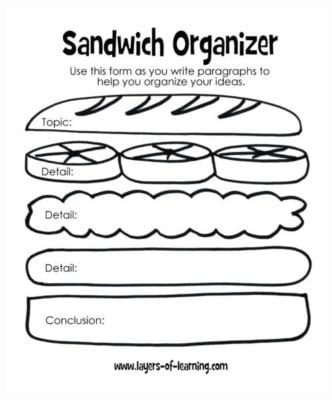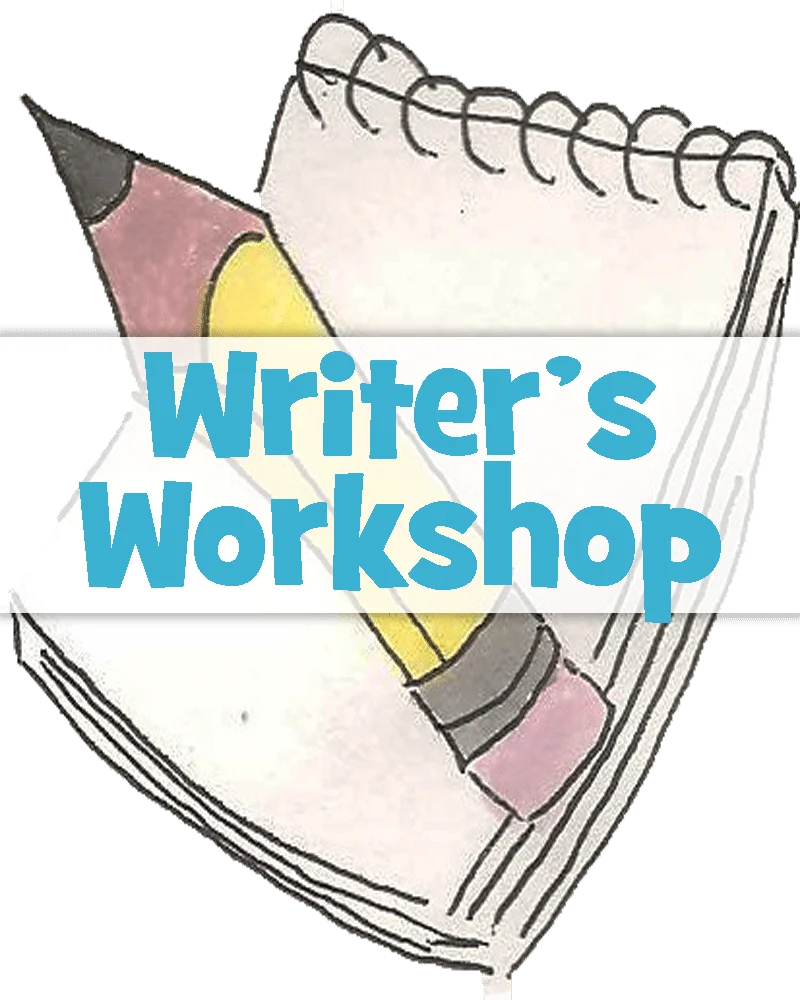Writer’s Workshop is a writing program for your whole family, from emergent writers right up to Mom and Dad. This is a sample exercise about teaching kids to write paragraphs. Try it with all your kids. This is a lesson that likely won’t happen in a single day. Writer’s Workshop doesn’t have a daily agenda. You get to stop as needed and pick up again right where you left off the next day – flexibility within a framework.
This Writer’s Workshop exercise is from Writer’s Workshop Sentences, Paragraphs, and Narrations, which is the second unit of the Writer’s Workshop program. In Writer’s Workshop Sentences, Paragraphs, and Narrations, you’ll learn how to construct sentences and paragraphs, then you’ll practice writing narrations and other short answer response writing. Join us for a family-style writing program in Writer’s Workshop.
The transition from learning to write sentences to tackling a paragraph can be daunting. Indeed, a youngster can get overwhelmed at the tasks of choosing a topic, thinking of related ideas, organizing, drafting the paragraph, editing, revising, and ending with a polished paragraph. Just talking about the steps can seem exhausting and overwhelming! Guide them through it by showing them how a paragraph is a lot like a sandwich. A sandwich has two pieces of bread, just as a paragraph has a topic sentence and a conclusion that hold the ideas together. The middle sentences need to be things that go well with the sandwich. You wouldn’t want something unrelated on your sandwich – like a scoop of ice cream or a bowl of soup. Make sure that you build your sandwich with things that belong there and support the main idea. Let’s have a mini-lesson before we begin though.
Step 1 Mini Lesson
Start each Writer’s Workshop lesson off with a 5-10 minute mini-lesson, with all of your kids. The sidebars of each Writer’s Workshop unit are lined with mini-lesson ideas to choose between. For this lesson, you could review the end marks that belong at the end of a sentence – periods, exclamation points, and question marks.
Have everyone craft their own sentences, one with a period, one with an exclamation point, and one with a question mark. Offer a topic and give the kids the challenge of making all of the sentences related to that topic. The topic could be a person you know, a place you’ve visited, or something you’re learning about in history, geography, science, art, or in a read-aloud.
Step 2 Exercise: Paragraph Sandwich
Spend most of your Writer’s Workshop time on the exercise, which should last as long or as short as you need it to, day to day.
To write a paragraph, first, you need a topic. Let’s say you are studying the Civil War. I like to give kids an umbrella topic (like Civil War) and a few specific options to choose from (like the Underground Railroad, Abraham Lincoln, or Civil War spies).
Next, you’ll need to do some reading. As you read about the topic, write down things you learn about the topic on the Sandwich Organizer. Talk about where the information belongs on the sandwich. Click on the picture below to get the printable.

Draft
Now it’s time to draft. What is the MAIN IDEA of your whole paragraph? All of the details should somehow talk about that main idea. In a complete sentence, write the main idea, followed by the supporting details, and finally the concluding sentence.
TOPIC SENTENCE:
Abraham Lincoln did many great things in his life.
SUPPORTING DETAIL:
When he was young, he was so honest that he walked miles to return six cents to a woman who had accidentally paid him too much.
SUPPORTING DETAIL:
He learned as much as he could and eventually became a lawyer.
SUPPORTING DETAIL:
Later, as president of the United States, he freed the slaves and did all he could to keep the country together during the Civil War.
CONCLUDING SENTENCE:
From the time Abraham Lincoln was born until the time he died he helped people and did what he thought was right.
Paragraph Form
Then, it can be written in paragraph form. Paragraphs are indented, so remember to indent your topic sentence.
Abraham Lincoln did many great things in his life. When he was young, he was so honest that he walked miles to return six cents to a woman who had accidentally paid him too much. He learned as much as he could and eventually became a lawyer. Later, as president of the United States, he freed the slaves and did all he could to keep the country together during the Civil War. From the time Abraham Lincoln was born until the time he died he helped people and did what he thought was right.
This exercise will go into the Journal section of the Writer’s Notebook, because it is finished, but not edited or revised yet. You may want to edit and revise it to use as your writing project for the month.
Step 3: Writing Project
Most exercises stay in the Writer’s Notebook to be used a reference, inspiration, or to be tossed at a later date. About once a month, one piece of writing should be taken clear through the writing process. This is your writing project.
To revise, you might check for awkward sentences and find ways to be clearer or add more details. Then, edit it by checking for spelling mistakes and grammatical errors. Make sure each sentence begins with a capital and ends with the appropriate end mark.
After building a few sandwich paragraphs, you’ll be able to write your first reports based on these same ideas.
You can learn details about the writing process and how to guide writers in the Writer’s Workshop Guidebook.
Step 4: Evaluating Writing
Every piece of writing that makes it to publication needs to be shared before an audience and then evaluated. The audience should cheer for the writer and ask curious and positive questions about the writing when appropriate. Evaluations should be designed to help the writer grow, not just to create a grade. Every Writer’s Workshop unit comes with specific helps for the evaluator, including a rubric that is specific to the genre being taught. General writing evaluation criteria and strategies are taught to the parent in the Writer’s Workshop Guidebook.
A Special Note About Teaching Paragraphs
One final parting note – I am bothered by teachers who tell kids that every paragraph must have five sentences and every essay must have five paragraphs. It simply isn’t true! A five-sentence paragraph and a five-paragraph essay are great places to begin for learning purposes, but writers should NEVER feel stuck in a format. It’s important to be able to include enough details to support your points. Knowing how to write a solid five-sentence paragraph and a five-paragraph essay is really important. Don’t let form get in the way of function though. Maybe your little one wants to include Lincoln delivering the moving Gettysburg Address. . . just add a piece of cheese to the sandwich!
What You’ll Find in Every Writer’s Workshop Unit
Printables
You’ll find printables in every Writer’s Workshop unit. They are tools for helping kids learn the writing process, skills, and ways to write in specific genres. They make lessons in a family-school setting a little more manageable for parents too.
Ideas Banks
In each unit, kids will be doing a variety of writing exercises as well as one project. They will learn to take their project through the writing process, incorporating what they’ve learned during the exercises. Each unit has a big idea bank for kids to choose from so they can find something meaningful that they get to choose to write about in each genre.
Rubrics
Every unit also includes a rubric to help parents or mentors know how to give feedback that will help writers grow. Rubrics are tools writers can use to self-check, and mentors can use to know what to look for in each writing genre. We never just slap a grade on writing. Every bit of feedback is a tool to improve and grow.
More Writer’s Workshop

Learn more about Writer’s Workshop and how it can help you create writers (not just grammar workbook filler-outers!). We invite you to check out the Writer’s Workshop Curriculum Guide. Then see how Layers of Learning can change your whole homeschool into a happy, hands-on family school with the Writer’s Workshop Guidebook. We believe learning is about exploring! If you like exploring, you’ll love the rest of the Layers of Learning program too – history, geography, science, and art, all taught with your whole family exploring together.
Get a Free Unit
Choose between the first unit in each Layers of Learning subject to try for free when you sign up for the newsletter.
We never spam and you can cancel your subscription at any time.




Thanks so much for having this available in order for us to teach our kids! Teaching them to write like elementary students is so important so they can gain confidence for Jr. High and High School!!
So thankful for the sandwich organizer! And the sample writing too!!
You are welcome!
Thank you for this very helpful tool!
This is helpful
Thank you so much for this helpful too. God bless you.
Thank you so much
You are very welcome Sylvia! 🙂
Thank you very much, this is really helping me teach my class better and they don’t find writing a report stressful or hard anymore. =)
This website is very useful to young learners! Thanks so much!
Thank you EVER so much for this! I used this with both grandkids! Love the concept – and although I think the 2 year old has “got it” and has no problem with the first reports – the almost 5 yo may have to have the sandwich whittled down to a snack cracker with cheese! (Attention deficit – runs in the family!) so we’ll be working on snack crackers (2 sentences) for a while before we increase to 3, then 4, then 5. This isn’t about the program but about learning how to stay focused on the topic – even when not interested in it (and, yes, he did choose the topic!)
Thank you so much. This has been helpful.
Do you tutor kids? We could use your help!
No, Layers of Learning is a curriculum company. We provide instructional materials.
FYI the printable is not loading for this page.